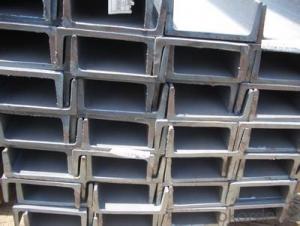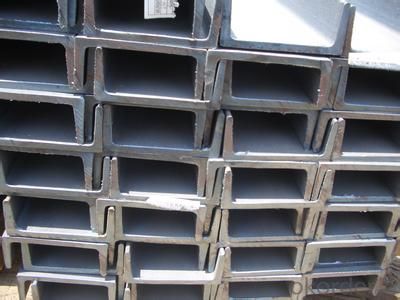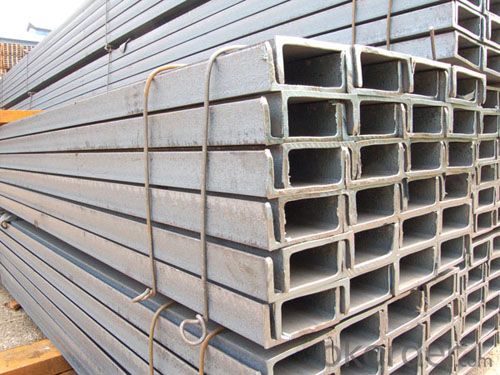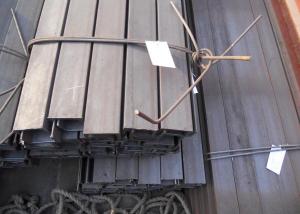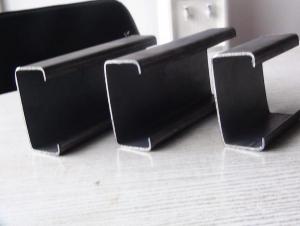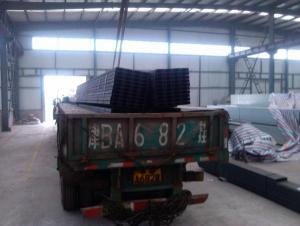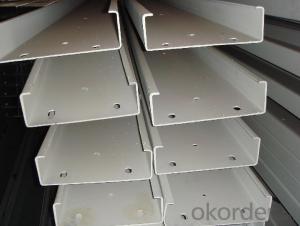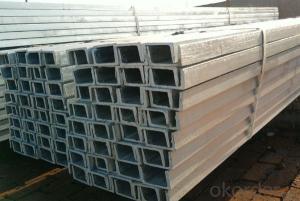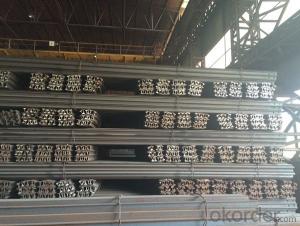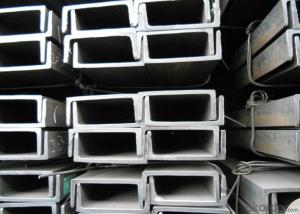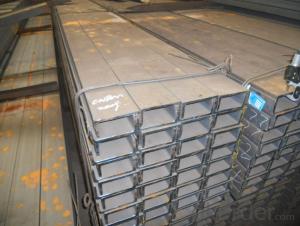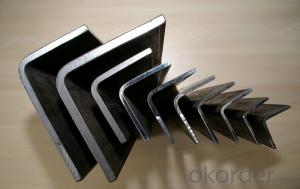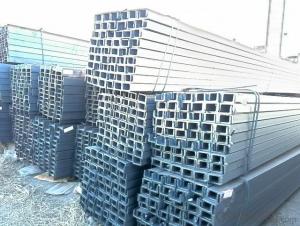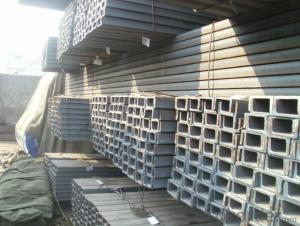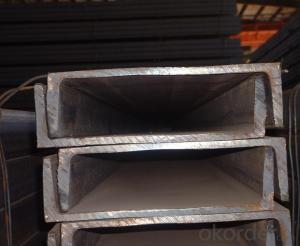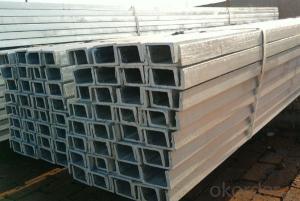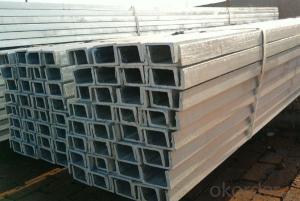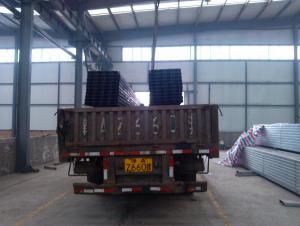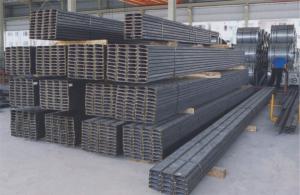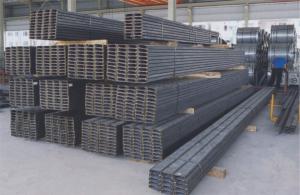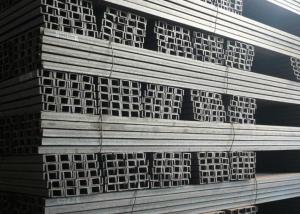HIGH QUALITY JIS U CHANNEL
- Loading Port:
- China Main Port
- Payment Terms:
- TT OR LC
- Min Order Qty:
- -
- Supply Capability:
- -
OKorder Service Pledge
OKorder Financial Service
You Might Also Like
CHANNEL Details:
| Minimum Order Quantity: | | Unit: | m.t. | Loading Port: | |
| Supply Ability: | | Payment Terms: | | Package: | wire bundle |
Product Description:
Specifications of MS Channel:
1.We supply high quality MS Channel at reasonable price, including Chinese standard, Japanese standard and so on.
Standard | GB/JIS |
Material Grade | Q235,SS400 |
Technique: | Hot Rolled |
Sizes as per chinese standard: | 50*37*4.5mm - 300*89*11.5mm |
Sizes as per japanese standard: | 50*25*3mm – 200*80*7.5mm |
Length: | 6meter, 9meter, 12meter |
Note: 1.we are also competent to provide our customers other MS Channel based on other sizes according to customer’s requirements.
2. The length of our ms channel could be cut into other meters as per customer’s requirements. For example, the channel in 6meters could be cut into 5.8meters in order to be fit in the 20ft container.
2. The detailed sections of MS Channel as per GB standard.are shown in the table-1:
GB U CHANNEL | Standard | Sectional | Dimension |
| Mass: |
| (mm) | (mm) | (mm) | (mm) |
|
50X37 | 50 | 37 | 4.50 | 7.0 | 5.438 |
63X40 | 63 | 40 | 4.80 | 7.5 | 6.634 |
80x43 | 80 | 43 | 5.00 | 8.0 | 8.045 |
|
|
|
|
|
|
100x48 | 100 | 48 | 5.30 | 8.5 | 10.007 |
120x53 | 120 | 53 | 5.50 | 9.0 | 12.059 |
140x58 | 140 | 58 | 6.00 | 9.5 | 14.535 |
140x60 | 140 | 60 | 8.00 | 9.5 | 16.733 |
|
|
|
|
|
|
160x63 | 160 | 63 | 6.50 | 10.0 | 17.240 |
160x65 | 160 | 65 | 8.50 | 10.0 | 19.752 |
|
|
|
|
|
|
180x68 | 180 | 68 | 7.00 | 10.5 | 20.174 |
180x70 | 180 | 70 | 9.00 | 10.5 | 23.000 |
|
|
|
|
|
|
200x73 | 200 | 73 | 7.00 | 11.0 | 22.637 |
200x75 | 200 | 75 | 9.00 | 11.0 | 25.777 |
|
|
|
|
|
|
220x77 | 220 | 77 | 7.00 | 11.5 | 24.999 |
220x79 | 220 | 79 | 9.00 | 11.5 | 28.453 |
|
|
|
|
|
|
250x78 | 250 | 78 | 7.00 | 12.0 | 27.410 |
250x80 | 250 | 80 | 9.00 | 12.0 | 31.335 |
250x82 | 250 | 82 | 11.00 | 12.0 | 35.260 |
|
| |
|
|
|
280x82 | 280 | 82 | 7.50 | 12.5 | 31.427 |
280x84 | 280 | 84 | 9.50 | 12.5 | 35.823 |
280x86 | 280 | 86 | 11.50 | 12.5 | 40.219 |
|
|
|
|
|
|
300x85 | 300 | 85 | 7.50 | 13.5 | 34.463 |
300x87 | 300 | 87 | 9.50 | 13.5 | 39.173 |
300x89 | 300 | 89 | 11.50 | 13.5 | 43.883 |
Table-1
3. The chemical composition of HR Channel Steel according to Q235B is shown in Table-2.
Alloy No | Grade | Element(%) | ||||
C | Mn | S | P | Si | ||
Q235 | B | 0.12-0.20 | 0.3-0.7 | ≦0.045 | ≦0.045 | ≦0.3 |
Table-2
Note: we are able to present our customers relevant SGS test report for chemical composition of HR Channel Steel.
4. The mechanical property of HR Channel Steel according to Q235B is shown in Table-3-1 and Table-3-2
Alloy No | Grade | Yielding Strength Point(Mpa) | |||
Thickness(mm) | |||||
≦16 | >16-40 | >40-60 | >60-100 | ||
≧ | |||||
Q235 | B | 235 | 225 | 215 | 205 |
Table-3-1
Alloy No | Grade | Tensile Strength(Mpa) | Elongation After Fracture(%) | |||
| | Thickness(mm) | |||||
≦16 | >16-40 | >40-60 | >60-100 | |||
≧ | ||||||
G235 | B | 375-500 | 26 | 25 | 24 | 23 |
Table-3-2
Note: we are able to present our customers relevant SGS test report for mechanical property of MS Channel as customer’s request.
Applications of MS Channel:
The MS Channel can be applied to construction of warehouses, workshops, sport stadiums and car parks etc.The hot rolled channel steel belongs to carbon structural steel which is applied to in the field of construction and machinery.In details, the hot rolled channel steel is usually used for arch-itechtural structure, and they could be welded in order to support or hang a vari-ety of facilities. They are also usually used in combination with I beam. Generally,the hot rolled channel steel we supply must possess perfect welding property, riveting property and mechanical property and so on.
Package & Delivery of MS Channel:
1.The hot rolled channel steel will be packed in bundle with steel wire at each end of every bundle and color marking in order to help the customer to recognize his goods more easily at sight.
2. And the hot rolled channel steel could be loaded into 20ft or 40ft container, or by bulk cargo.If the weight of each bundle reaches more than 3.5 mt, the loading by break bulk cargo should be choosed.When the weight of each bundle reaches less than 3mt, the loading by container should be choosed.
3.As for the transportaion from mill to loading port, the truck will be usually used. And the maximum quantity for each truck is 40mt.
4.All in all, we could do in accordance with customer's request
- Q: What are the different installation methods for steel channels?
- There are several different installation methods for steel channels, depending on the specific application and requirements. Some common methods include bolting, welding, and using adhesive or construction adhesive. Each method has its own advantages and considerations, such as strength, durability, ease of installation, and cost. The choice of installation method should be based on factors such as load capacity, environmental conditions, and the desired aesthetic appearance.
- Q: What is the lifespan of steel channels?
- The lifespan of steel channels can vary depending on various factors such as the quality of the steel, environmental conditions, and maintenance. However, with proper care and regular maintenance, steel channels can have a lifespan of several decades or even more.
- Q: What are the load-bearing capabilities of steel channels?
- Steel channels have high load-bearing capabilities due to their structural design and material strength. The load-bearing capacity of steel channels depends on various factors such as the size, shape, and thickness of the channel, as well as the type of steel used. However, in general, steel channels are known for their ability to support heavy loads and are commonly used in construction and engineering projects where strength and durability are crucial.
- Q: How do steel channels contribute to the overall ventilation of a building?
- Steel channels are an integral part of the overall ventilation system in a building as they provide pathways for the movement of air. These channels are strategically placed throughout the structure, allowing fresh air to enter and stale air to exit. By facilitating proper airflow, steel channels help regulate temperature, remove pollutants, and improve air quality, thereby contributing to a healthier and more comfortable environment inside the building.
- Q: How to choose angle steel and channel steel for dry hanging stone?
- The specifications of the metal frame used for hanging stone are mainly the thickness of the stone and the strength of the wall!
- Q: Can steel channels be used in railway and transportation infrastructure?
- Yes, steel channels can be used in railway and transportation infrastructure. Steel channels are commonly used in the construction of railway tracks, bridges, and other transportation structures due to their high strength and durability. They provide structural support and stability to the infrastructure, ensuring safe and reliable transportation. Steel channels also offer resistance to heavy loads, corrosion, and extreme weather conditions, making them suitable for use in railway and transportation projects. Additionally, steel channels can be easily fabricated and installed, allowing for efficient construction and maintenance of the infrastructure. Overall, steel channels are a preferred choice in railway and transportation infrastructure due to their excellent mechanical properties and long-term performance.
- Q: Can steel channels be used in seismic design?
- Seismic design can make effective use of steel channels, also referred to as steel C channels or C beams. These channels are widely utilized in seismic design due to their exceptional strength, stability, and ductility. The main objective of seismic design is to ensure that structures are capable of withstanding the powerful forces produced during an earthquake. Steel channels are commonly employed as structural components in earthquake-resistant building systems because they possess the ability to absorb and dissipate energy. They exhibit a high capacity for carrying loads, demonstrate exceptional resistance to bending and torsion, and effectively endure lateral forces resulting from seismic activity. Furthermore, steel channels can be tailored and manufactured to meet specific requirements of seismic design, such as incorporating thicker steel plates or additional reinforcement. In summary, steel channels are a versatile and dependable choice for various seismic design applications.
- Q: What are the different design codes and standards for steel channels?
- Steel channels are subject to numerous design codes and standards that ensure their structural integrity and safety. The American Institute of Steel Construction (AISC) Specification for Structural Steel Buildings is a well-known code that offers comprehensive guidelines for the design, detailing, and construction of steel structures, including channels. It covers various topics like permissible stress design, load combinations, and connection design requirements. Apart from the AISC Specification, there are other applicable design codes and standards for steel channels, depending on their specific use. For example, the American Society of Civil Engineers (ASCE) 7-16 Minimum Design Loads and Associated Criteria for Buildings and Other Structures provides guidelines for determining design loads, which are crucial in channel design. The ASTM A36/A36M specification is another pertinent standard that outlines the requirements for carbon structural steel, including channels. It encompasses chemical composition, mechanical properties, and other specifications for carbon steel materials. Furthermore, the International Building Code (IBC) is a widely adopted and enforced model code in many countries. It includes provisions for the design and construction of steel structures, ensuring compliance with safety and performance requirements. It is important to acknowledge that design codes and standards can vary depending on the country or region. Therefore, consulting the relevant local codes and standards is essential when designing and constructing steel channels. Overall, these diverse design codes and standards provide engineers and designers with the necessary guidelines and requirements to ensure the safe and efficient design of steel channel structures. They cover various aspects, such as load calculations, material specifications, design methodologies, and construction practices, all aimed at ensuring the structural integrity and safety of steel channels.
- Q: Are steel channels suitable for agricultural storage buildings?
- Agricultural storage buildings can indeed make use of steel channels. Steel channels, which are also referred to as C-channels or U-channels, are commonly utilized in the construction industry because of their strength and durability. They provide robust structural support and have the ability to handle heavy loads, making them perfect for storing agricultural machinery, equipment, and livestock feed. Moreover, steel channels possess resistance against pests, fire, and rot, which guarantees the safety and longevity of the storage building. They are also highly adaptable and can be easily customized to fulfill specific storage requirements, such as the addition of shelves or hooks for hanging tools and equipment. In summary, steel channels are a dependable option for agricultural storage buildings, offering a solid and secure solution for farmers and agricultural businesses.
- Q: What are the different methods for cutting steel channels?
- There are several methods for cutting steel channels, including manual methods such as hacksaw or chisel, power tools like angle grinders or reciprocating saws, and more advanced methods like plasma cutting or water jet cutting. The choice of method depends on factors such as the thickness and type of steel, desired precision, and available equipment.
Send your message to us
HIGH QUALITY JIS U CHANNEL
- Loading Port:
- China Main Port
- Payment Terms:
- TT OR LC
- Min Order Qty:
- -
- Supply Capability:
- -
OKorder Service Pledge
OKorder Financial Service
Similar products
Hot products
Hot Searches
Related keywords
